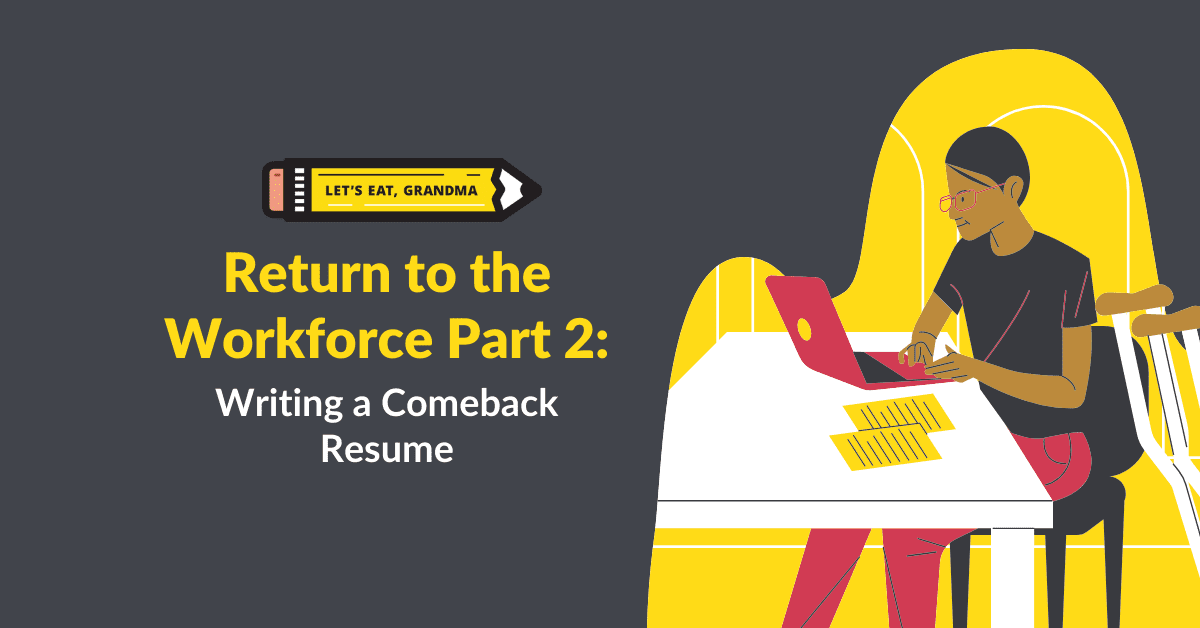Return to the Workforce, Part 2: How to Structure Your Comeback Resume

Are you looking to return to the workforce after a pandemic gap spent after taking time off to care for children? It can be overwhelming to relaunch your career, so we’ve compiled a few specific tips to help you build your new resume.
By: Tonyia Cone | Contributor for Let’s Eat, Grandma
There’s way more to life than work, and it is absolutely valid that you took a break from employment to be a full-time parent over the past year and a half. However, that time “off” is likely a source of stress now that you’re trying to return to work.
But it doesn’t have to be, especially when the job market is transitioning after 2020 and the worst U.S. recession in history, at a time when some industries are experiencing acute labor shortages, and now, through the Great Resignation. When so many people and employers are in flux, a career gap is not the deal breaker it may have once been.
Tired of not landing interviews?
Get our free 3-step guide to writing better resume bullet points, featuring 70 ideas for metrics you can use!
A gap may raise questions from a potential employer, but here are steps you can take to structure your comeback resume to ensure it doesn’t raise a red flag.
(P.S. If you don’t yet know just where to start with explaining your recent gap, first go read Part 1 of this series, and then come back for some technical tips!)
Choose the right format
There are three main types of resume formats:
Chronological

Using a nonstandard resume format can backfire if it is difficult for a hiring manager to scan for pertinent information. Photo by Van Tay Media on Unsplash
Chronological resumes list experience in reverse-chronological order. Chronological resumes are the most common and safest format, so in most cases, this is the best option. Recruiters and hiring managers prefer them, and when done right, they are also most likely to be processed correctly in an Applicant Tracking System (ATS), the software many employers use to organize job applications they receive.
Functional
Many job seekers think the best approach to writing a resume that covers up a career gap is to choose a functional resume. With a focus on skills and experience, a functional resume de-emphasizes the positions you’ve held.
At first glance, that may seem like a great idea, but this approach is problematic and is best avoided. Functional resumes are not ATS-friendly, meaning a functional resume is more likely to be scrambled by the software and less likely to come up in a recruiter’s search results.
In addition, recruiters know that applicants often use the functional resume format to hide something, so this approach can be an immediate red flag. A less attention-getting way to handle a gap while showing when you held each position is to omit the months and list only years.
Using a non-standard format like a functional resume also makes it harder for recruiters and hiring managers to find the information they need. The people who first read job applications can spend only a matter of seconds on your resume to decide if you are a good fit for their role. So you need to make their job as quick and easy as possible for them if you want to make it to the next step in the hiring process.
Hybrid
A third option is a hybrid or combination resume. As its name suggests, a hybrid resume combines the skills-focused functional resume with a user-friendly chronological resume. If you execute this well, this may be an alternative format that talks up your skills while minimizing a gap.
Pump it up! Build a strong Summary
Chronological and hybrid resumes can both be strengthened with a powerful Summary of Qualifications section before they even get to your career gap. (Our fellow resume writer Lezlie Garr even said she considers this the most essential section for a resume on our podcast!)
Use this section to set the tone, highlight your most impressive career-related achievements, and align your background and skills with the position you are applying for. If this is the only part of your resume that a reader considers, what do you want them to take away about your experience? You can also use this space to counter any false assumptions a hiring manager or recruiter might make about you based on your career gap.
It is really important to remember that your resume and cover letter are living documents; you should update them for each job description you are applying to, highlighting your most relevant experience and achievements.
Keep it fresh
If you have time before making your comeback, volunteering and earning a certification or two can be great ways to smooth over a gap by freshening up your qualifications.
Continuing education and certifications

Online continuing education courses are a great way to modernize your skillset. Photo by Gabriel Benois on Unsplash
If you’ve been out of the workforce long enough, you may not just be facing a career gap. Technology changes constantly and your skills may also now be out-of-date.
The great news is there’s probably never been an easier time to continue your education since the pandemic moved pretty much everything online. Enrollment in online education platforms has skyrocketed since March 2020, and opportunities abound, from online degree programs to free certifications. If you consistently lack a requirement for the jobs you are applying for, this can be a great way to sharpen your skills. Just make sure you keep your resume up to date with all the great new qualifications you’re earning.
Volunteering
When I finished graduate school, I began working full-time but really wanted to shift my focus to a more flexible freelance journalism and public relations career as I was starting my family. I became involved in a professional association as a volunteer newsletter editor and a board member. I gained writing samples, and more importantly these roles expanded my network, which ended up helping me get my foot in the door and launch my freelance writing business.
I also volunteered to write press releases for my synagogue — which led to 15 years of consistent reporting and editing work for a local newspaper. I leaned into my hobbies too by volunteering for running and triathlon group newsletters, which led to a fun gig interviewing local celebrities for a running company blog.
This goes to show, volunteering for a cause you care about in a way that leverages your professional strengths can be fulfilling, interesting, and a powerful way to network (without having to make uncomfortable small talk) and gain recent experience. And you never know, you might make the world a better place while you’re at it.
(Don’t) Mind the gap
While your pandemic parenting gap is something to address when creating your new resume, there are steps you can take to honestly, but briefly, address your time off. Then you can move the conversation on to what’s really important — what makes you a fantastic candidate.
Ready for more job search help?
Sign up for a free Senior Writer Resume Critique to see what's holding you back from landing interviews. One of our top professional resume writers will give you personalized feedback on the top 3 items you can improve based on our expert practices!
